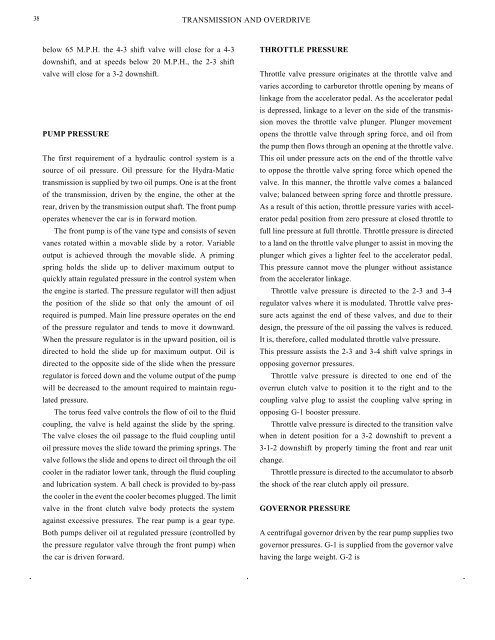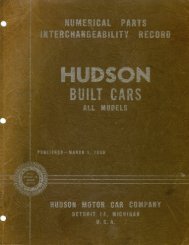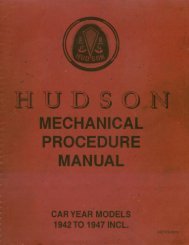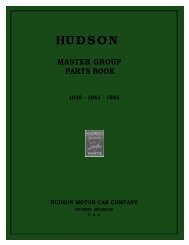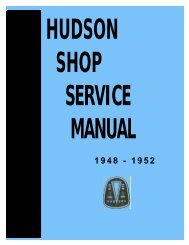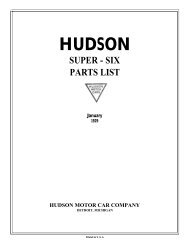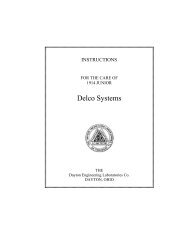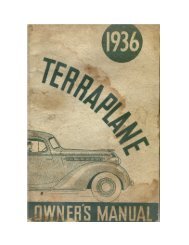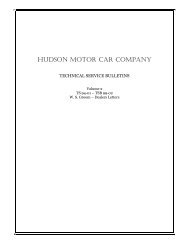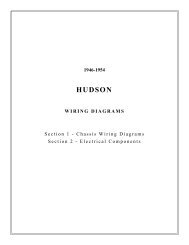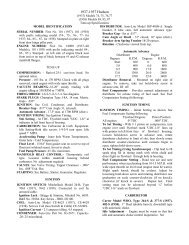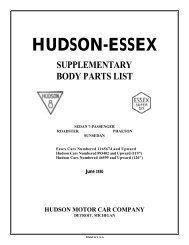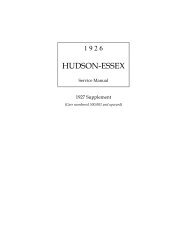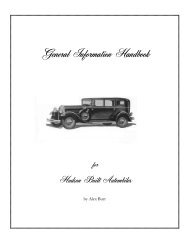1956 AMC Hudson Technical Service Manual Supplement
1956 AMC Hudson Technical Service Manual Supplement
1956 AMC Hudson Technical Service Manual Supplement
You also want an ePaper? Increase the reach of your titles
YUMPU automatically turns print PDFs into web optimized ePapers that Google loves.
38 TRANSMISSION AND OVERDRIVE<br />
below 65 M.P.H. the 4-3 shift valve will close for a 4-3<br />
downshift, and at speeds below 20 M.P.H., the 2-3 shift<br />
valve will close for a 3-2 downshift.<br />
PUMP PRESSURE<br />
The first requirement of a hydraulic control system is a<br />
source of oil pressure. Oil pressure for the Hydra-Matic<br />
transmission is supplied by two oil pumps. One is at the front<br />
of the transmission, driven by the engine, the other at the<br />
rear, driven by the transmission output shaft. The front pump<br />
operates whenever the car is in forward motion.<br />
The front pump is of the vane type and consists of seven<br />
vanes rotated within a movable slide by a rotor. Variable<br />
output is achieved through the movable slide. A priming<br />
spring holds the slide up to deliver maximum output to<br />
quickly attain regulated pressure in the control system when<br />
the engine is started. The pressure regulator will then adjust<br />
the position of the slide so that only the amount of oil<br />
required is pumped. Main line pressure operates on the end<br />
of the pressure regulator and tends to move it downward.<br />
When the pressure regulator is in the upward position, oil is<br />
directed to hold the slide up for maximum output. Oil is<br />
directed to the opposite side of the slide when the pressure<br />
regulator is forced down and the volume output of the pump<br />
will be decreased to the amount required to maintain regulated<br />
pressure.<br />
The torus feed valve controls the flow of oil to the fluid<br />
coupling, the valve is held against the slide by the spring.<br />
The valve closes the oil passage to the fluid coupling until<br />
oil pressure moves the slide toward the priming springs. The<br />
valve follows the slide and opens to direct oil through the oil<br />
cooler in the radiator lower tank, through the fluid coupling<br />
and lubrication system. A ball check is provided to by-pass<br />
the cooler in the event the cooler becomes plugged. The limit<br />
valve in the front clutch valve body protects the system<br />
against excessive pressures. The rear pump is a gear type.<br />
Both pumps deliver oil at regulated pressure (controlled by<br />
the pressure regulator valve through the front pump) when<br />
the car is driven forward.<br />
THROTTLE PRESSURE<br />
Throttle valve pressure originates at the throttle valve and<br />
varies according to carburetor throttle opening by means of<br />
linkage from the accelerator pedal. As the accelerator pedal<br />
is depressed, linkage to a lever on the side of the transmission<br />
moves the throttle valve plunger. Plunger movement<br />
opens the throttle valve through spring force, and oil from<br />
the pump then flows through an opening at the throttle valve.<br />
This oil under pressure acts on the end of the throttle valve<br />
to oppose the throttle valve spring force which opened the<br />
valve. In this manner, the throttle valve comes a balanced<br />
valve; balanced between spring force and throttle pressure.<br />
As a result of this action, throttle pressure varies with accelerator<br />
pedal position from zero pressure at closed throttle to<br />
full line pressure at full throttle. Throttle pressure is directed<br />
to a land on the throttle valve plunger to assist in moving the<br />
plunger which gives a lighter feel to the accelerator pedal.<br />
This pressure cannot move the plunger without assistance<br />
from the accelerator linkage.<br />
Throttle valve pressure is directed to the 2-3 and 3-4<br />
regulator valves where it is modulated. Throttle valve pressure<br />
acts against the end of these valves, and due to their<br />
design, the pressure of the oil passing the valves is reduced.<br />
It is, therefore, called modulated throttle valve pressure.<br />
This pressure assists the 2-3 and 3-4 shift valve springs in<br />
opposing governor pressures.<br />
Throttle valve pressure is directed to one end of the<br />
overrun clutch valve to position it to the right and to the<br />
coupling valve plug to assist the coupling valve spring in<br />
opposing G-1 booster pressure.<br />
Throttle valve pressure is directed to the transition valve<br />
when in detent position for a 3-2 downshift to prevent a<br />
3-1-2 downshift by properly timing the front and rear unit<br />
change.<br />
Throttle pressure is directed to the accumulator to absorb<br />
the shock of the rear clutch apply oil pressure.<br />
GOVERNOR PRESSURE<br />
A centrifugal governor driven by the rear pump supplies two<br />
governor pressures. G-1 is supplied from the governor valve<br />
having the large weight. G-2 is


